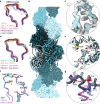Toxoplasma gondii actin filaments are tuned for rapid disassembly and turnover
- PMID: 38418447
- PMCID: PMC10902351
- DOI: 10.1038/s41467-024-46111-3
Toxoplasma gondii actin filaments are tuned for rapid disassembly and turnover
Abstract
The cytoskeletal protein actin plays a critical role in the pathogenicity of the intracellular parasite, Toxoplasma gondii, mediating invasion and egress, cargo transport, and organelle inheritance. Advances in live cell imaging have revealed extensive filamentous actin networks in the Apicomplexan parasite, but there are conflicting data regarding the biochemical and biophysical properties of Toxoplasma actin. Here, we imaged the in vitro assembly of individual Toxoplasma actin filaments in real time, showing that native, unstabilized filaments grow tens of microns in length. Unlike skeletal muscle actin, Toxoplasma filaments intrinsically undergo rapid treadmilling due to a high critical concentration, fast monomer dissociation, and rapid nucleotide exchange. Cryo-EM structures of jasplakinolide-stabilized and native (i.e. unstabilized) filaments show an architecture like skeletal actin, with differences in assembly contacts in the D-loop that explain the dynamic nature of the filament, likely a conserved feature of Apicomplexan actin. This work demonstrates that evolutionary changes at assembly interfaces can tune the dynamic properties of actin filaments without disrupting their conserved structure.
© 2024. The Author(s).
Conflict of interest statement
The authors declare no competing interests.
Figures






Update of
-
Toxoplasma gondii actin filaments are tuned for rapid disassembly and turnover.bioRxiv [Preprint]. 2023 Aug 30:2023.08.29.555340. doi: 10.1101/2023.08.29.555340. bioRxiv. 2023. Update in: Nat Commun. 2024 Feb 28;15(1):1840. doi: 10.1038/s41467-024-46111-3. PMID: 37693530 Free PMC article. Updated. Preprint.
References
MeSH terms
Substances
Grants and funding
LinkOut - more resources
Full Text Sources

